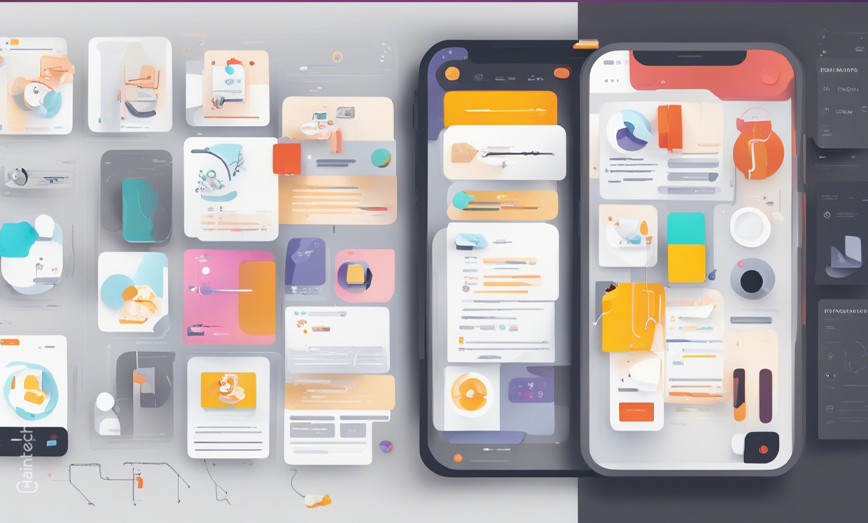Design Innovation: Transforming the Digital World

Introduction
In today’s digital age, where technology undergoes never-ending evolution, design innovation plays a crucial role in shaping the digital realm. The fusion of technology and design has revolutionized the way we interact with digital products and services. Design innovation has the power to enhance user experiences, create captivating narratives, and drive engagement. In this article, we will delve into the various facets of design innovation and explore how it is transforming the digital world.
Understanding Design Innovation
Defining design innovation and its impact on technology
Design innovation encompasses the process of developing novel solutions that integrate aesthetic appeal, functionality, and user-centricity. It involves utilizing imaginative thinking, creative problem-solving, and the effective utilization of technology to solve complex challenges. By pushing the boundaries of design, innovation has the potential to reshape the digital landscape and redefine user experiences.
Key principles and processes involved in design innovation
Design innovation involves a multitude of principles and processes. It embraces user-centered design, where end-user needs and desires are at the forefront of the design process. It also thrives on iterative ideation, prototyping, and testing to ensure the development of effective and user-friendly solutions. Collaboration across multidisciplinary teams and the integration of diverse perspectives are critical for fostering innovation in design.
The Role of Human-Centered Design
Human-centric approach: Placing users at the core of design
Human-centered design is an approach that prioritizes empathy and understanding of user needs. It advocates for involving users throughout the design process, enabling designers to create products that truly resonate with their target audience. By centering designs around human experiences, digital products can become more intuitive, inclusive, and user-friendly.
Enhancing user experience through empathetic design
Empathetic design focuses on understanding the emotions, motivations, and behaviors of users. By empathizing with their needs and desires, designers can craft experiences that are tailored to their target audience. This approach leads to the creation of products that not only meet functional requirements but also evoke positive emotions and provide meaningful interactions.
Evolution of Responsive Design
Introduction to responsive design and its relevance in a digital landscape
Responsive design is a design approach that aims to provide optimal user experiences across various devices and screen sizes. As the proliferation of smartphones, tablets, and other digital devices continues, responsive design has become essential for ensuring seamless interactions. It allows content to adapt and rearrange dynamically, providing users with consistent and user-friendly experiences regardless of the device they are using.
Adaptive and fluid layouts: Enabling optimal user interaction across devices
Responsive design achieves its goals through the utilization of adaptive and fluid layouts. Adaptive layouts allow content to respond to different screen sizes by rearranging and adjusting elements. Fluid layouts, on the other hand, enable content to expand or contract proportionally with the resizing of the screen, ensuring consistency and usability.
The Power of Visual Storytelling
Utilizing visual elements to create captivating narratives
Visual storytelling leverages the power of images, graphics, and illustrations to communicate compelling narratives. By incorporating visual elements into digital designs, brands can convey emotions, convey complex messages, and evoke strong connections with their audience. The human brain is highly responsive to visual stimuli, making visual storytelling a powerful tool for engaging users.
Infographics, videos, and interactive media: Engaging users through visuals
Infographics, videos, and interactive media play pivotal roles in captivating users’ attention and enhancing their experiences. Infographics present complex information in a visually appealing and accessible manner. Videos, on the other hand, engage users through dynamic visual content, enabling storytelling in a more immersive way. Interactive media allows users to actively engage with a design, fostering a deeper level of interaction and increasing user engagement.
Embracing Minimalism in Design
Simplifying interfaces for enhanced user experience
Minimalism in design involves stripping away unnecessary elements to create clean, uncluttered interfaces. By eliminating visual noise and focusing on essential elements, minimalistic designs provide users with intuitive and seamless experiences. Minimalism enhances usability by reducing cognitive load and allowing users to navigate interfaces effortlessly.
Minimalistic design trends and their impact on digital experiences
Minimalistic design trends, characterized by clean lines, ample white space, and limited color palettes, have gained significant traction in the digital realm. This design approach creates a sense of elegance, sophistication, and simplicity. Minimalistic designs not only provide visually pleasing aesthetics but also minimize distractions, allowing users to concentrate on the core functionality of a digital product.
Integrating UX and UI Design
The significance of harmonizing user experience and user interface design
UX (user experience) and UI (user interface) design are crucial components of the overall user journey. UX design focuses on understanding user needs, creating intuitive interactions, and designing seamless workflows. On the other hand, UI design focuses on the visual elements and aesthetics, ensuring a visually appealing and engaging interface. It is essential to integrate both aspects seamlessly to provide a coherent and delightful user experience.
Leveraging the synergy between UX and UI for intuitive digital products
When UX and UI design work harmoniously, they form a powerful duo that can create intuitive and user-friendly digital products. By aligning user goals with visual elements, designers can ensure that the interface feels intuitive and responsive to users’ actions. This synergy allows for the creation of digital products that are not only visually appealing but also provide seamless and satisfying interactions.
The Impact of Gamification
Gamifying experiences: Adding elements of fun and engagement
Gamification is the integration of game mechanics and elements into non-gaming contexts. By introducing elements such as challenges, rewards, and competition, designers can transform digital experiences into engaging and entertaining journeys. Gamification taps into users’ inherent desires for exploration, achievement, and social interaction, creating experiences that captivate and foster loyalty.
Game mechanics as a driving force for user interaction and loyalty
Game mechanics, such as points, badges, leaderboards, and progress tracking, incentivize users to actively engage with digital products. They create a sense of achievement and provide feedback on users’ progress, motivating them to continue interacting. By implementing well-designed game mechanics, designers can drive user interaction, increase user loyalty, and unleash the full potential of a digital product.
Designing for Accessibility and Inclusivity
Ensuring digital products are accessible to all users
Designing for accessibility and inclusivity means creating digital products that can be accessed and used by individuals with various abilities, including those with disabilities. It involves incorporating features and design elements that accommodate users with visual, auditory, cognitive, or motor impairments. By prioritizing accessibility, designers can ensure that digital experiences are available to all, regardless of their limitations.
Design principles for creating inclusive experiences
Creating inclusive experiences requires adhering to certain design principles. These include providing alternative text for images, using color contrast to ensure readability, implementing clear and concise navigation, and considering assistive technologies. By integrating these principles, designers can make digital products more accessible, usable, and enjoyable for a diverse range of users.
Innovations in Information Architecture
Streamlining digital content organization for effortless navigation
Information architecture involves organizing and structuring digital content in a way that enables users to find the information they need effortlessly. By adopting intuitive navigation systems, categorization methods, and search functionalities, designers can create well-organized digital spaces. Effective information architecture simplifies user journeys, reduces cognitive load, and enhances the overall user experience.
The role of AI in optimizing information architecture
Artificial intelligence (AI) plays an increasingly significant role in information architecture. AI technologies, such as machine learning and natural language processing, enable designers to create intelligent search functionalities, content recommendations, and personalized user experiences. By leveraging AI, designers can make information architecture more dynamic, tailored, and responsive to users’ needs.
Exploring the World of Virtual Reality
Immersive experiences through virtual reality
Virtual reality (VR) has revolutionized the way users interact with digital content by providing immersive and realistic experiences. By donning VR headsets, users are transported to virtual worlds where they can explore, engage, and interact with digital environments. VR offers endless possibilities for storytelling, gaming, education, and training, transforming the way we perceive and engage with digital experiences.
Design considerations and opportunities in VR development
Designing for virtual reality comes with unique considerations, such as spatial awareness, user comfort, and intuitive interactions. Designers need to take into account factors such as user perspective, depth perception, and motion sickness mitigation. Furthermore, the possibilities for innovation in VR development are vast, opening new doors for groundbreaking experiences in various industries, including entertainment, education, and healthcare.
Enhancing User Engagement with Microinteractions
The significance of microinteractions in improving user interactions
Microinteractions refer to small, subtle animations, sounds, or visual responses that occur in response to user actions. These interactions provide instant feedback, communicate system status, and create a sense of delight and satisfaction. By incorporating well-designed microinteractions, designers can enhance user interactions, create a more dynamic interface, and foster a sense of responsiveness.
Incorporating microinteractions into digital design
Incorporating microinteractions requires meticulous attention to detail and understanding of user behavior. Designers need to identify key moments for microinteractions, define appropriate feedback, and ensure consistency across different interactions. When executed effectively, microinteractions can transform mundane interactions into memorable experiences, thus increasing user engagement and satisfaction.
The Evolving Role of Typography in Design
Typography trends and their impact on digital aesthetics
Typography has moved beyond mere readability and has become a powerful design element in its own right. Emerging typography trends, such as variable fonts, expressive typography, and custom typefaces, allow designers to create visually captivating and engaging digital aesthetics. Typography sets the tone, conveys messages, and adds personality to the digital experience, making it a crucial component of design innovation.
Creating engaging designs through thoughtful typographic choices
Thoughtful typographic choices, such as font pairing, hierarchy, and spacing, contribute to the overall visual appeal and usability of digital designs. Typography sets the rhythm, guides the user’s reading flow, and emphasizes important elements. By selecting appropriate typefaces, optimizing readability, and experimenting with typographic styles, designers can create engaging designs that resonate with users and evoke desired emotions.
The Rise of Voice User Interfaces (VUI)
Harnessing the power of voice in digital interactions
Voice user interfaces (VUIs) allow users to interact with digital systems using voice commands or speech input. Voice assistants, such as Siri, Alexa, and Google Assistant, have become increasingly popular and have opened new avenues for digital interactions. VUIs offer hands-free and natural ways of engaging with digital products, enabling users to perform tasks, retrieve information, and control devices effortlessly.
Designing effective voice user interfaces for seamless experiences
Designing effective VUIs requires considering factors such as natural language understanding, conversational flow, and feedback mechanisms. Designers must ensure clarity in voice interactions, provide informative responses, and handle errors gracefully. By focusing on creating intuitive and delightful voice interactions, designers can harness the power of VUIs and create seamless experiences that augment user interactions.
How Design Thinking Spurs Innovation
Applying design thinking methodologies to drive innovation
Design thinking is a problem-solving approach that places empathy, collaboration, and iteration at its core. It involves understanding user needs, ideating potential solutions, prototyping, testing, and iterating based on feedback. Design thinking empowers designers to question assumptions, explore new possibilities, and generate innovative solutions that address real-world challenges.
Real-world examples showcasing design thinking’s impact on digital products
Design thinking has had a profound impact on the creation of successful digital products. Companies like Apple, IDEO, and Airbnb have embraced this approach, leading to the development of groundbreaking products that prioritize user experience. For instance, the design thinking approach has fueled the creation of user-friendly interfaces, intuitive interactions, and seamless integrations, ultimately revolutionizing the digital world.
Designing for Future Technologies
Considering emerging technologies for futuristic designs
As technology continues to evolve, designers must consider emerging trends and new technologies when shaping the digital future. Artificial intelligence, the Internet of Things, augmented reality, and blockchain are just a few examples of groundbreaking technologies that will redefine the digital landscape. By embracing these technologies early on and exploring their potential, designers can stay ahead of the curve and create innovative, future-proof designs.
Staying ahead of the curve: Designing for AI, IoT, and beyond
Designing for future technologies requires a forward-thinking mindset and adaptability. Designers must anticipate how AI, IoT, and other emerging technologies will impact user experiences and adjust their design approaches accordingly. This includes considering ethical implications, user privacy, and designing for seamless integration between devices and systems. By staying ahead, designers can shape the digital world and unlock its full potential.
Summary: Design Innovation in the Digital World
In summary, design innovation is a driving force behind the transformation of the digital world. By embracing human-centered approaches, employing responsive design techniques, leveraging visual storytelling, and incorporating minimalism, designers can create captivating digital experiences. The integration of UX and UI, gamification, accessibility, and inclusive design principles further enhance user engagement and satisfaction. As the digital landscape continues to evolve, designers must adapt to emerging technologies, embrace new design trends, and apply design thinking methodologies to revolutionize the way we interact with the digital realm.
Now that you have learned about the transformative potential of design innovation in the digital world, we encourage you to embrace this approach and shape the future of digital experiences through innovative and user-centric designs.









